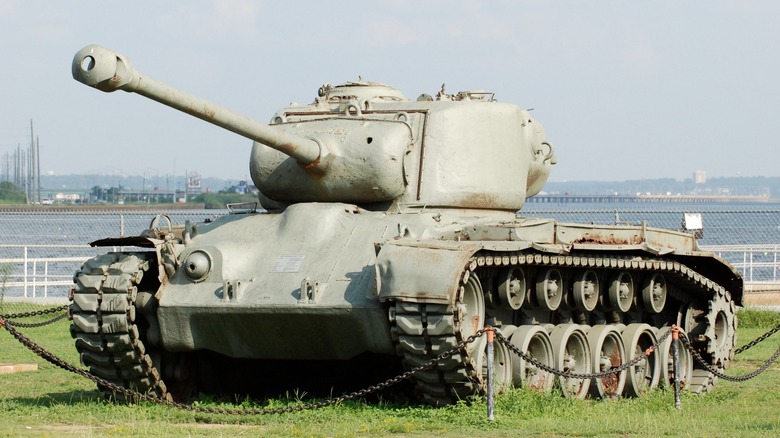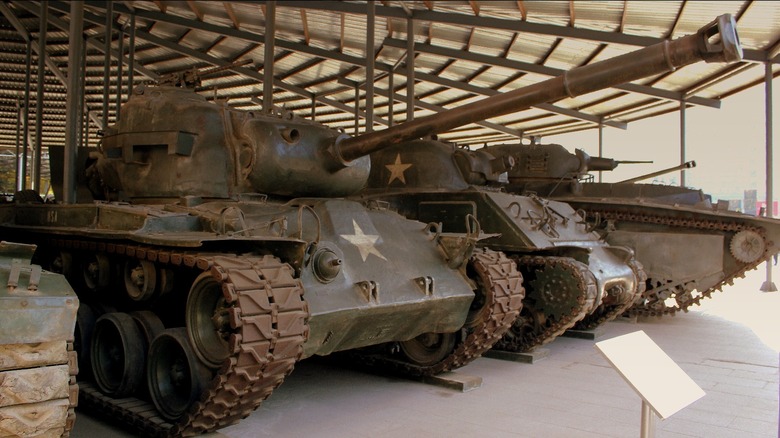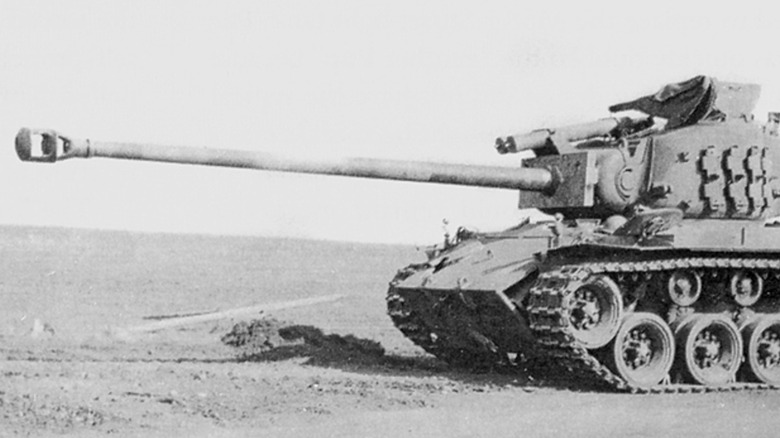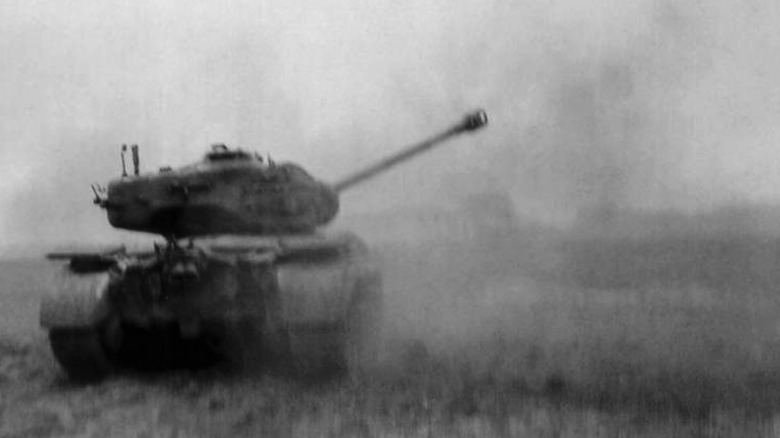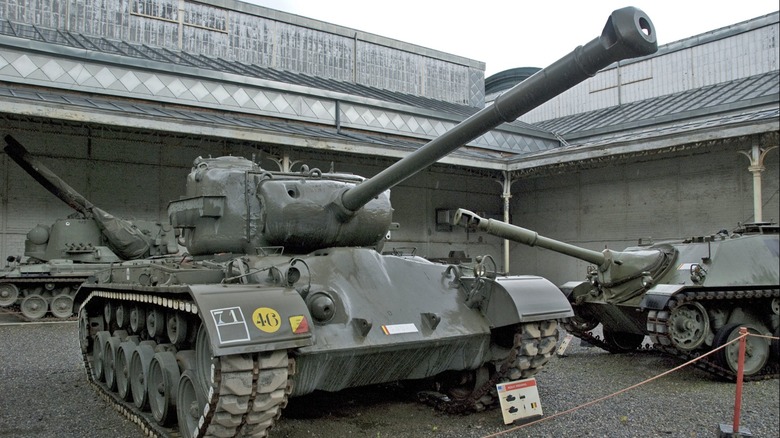Here's What Made The M26 Pershing Tank Unique From Its Predecessors
The most common American armored vehicle during World War II was the M4 Sherman. It was a good tank with decent armor and firepower capable of facing contemporary tanks like the German Panzer III and IV. However, the Germans continually made new tank models as the war dragged on.
The Americans also developed tanks to succeed the M4. However, the Heavy Tank M6—America's first heavy tank—wasn't a successful design, remaining stateside throughout the war and declared obsolete even before Germany surrendered. They also started developing the M26 Pershing to replace the Sherman. However, progress was slow as some American commanders opposed its production, deeming the current stable of armor sufficient for their needs. It wasn't until 1944 that production began for this tank.
On the other hand, the Germans were already fielding the powerful Panther medium tank and the fearsome Tiger heavy tank in 1943. These armored vehicles could overpower the M4 Sherman, as the Americans experienced during the Battle of the Bulge. Because of this, the American high command ordered the deployment of the M26 to European battlefields, with the first units arriving in January 1945.
More compact than the Sherman
The main difference between the M26 Pershing and the M4 Sherman is their profile. The Sherman had a tall hull that sat above its tracks. This meant it was a towering figure on the horizon, making it a bigger target.
The tall profile resulted from the Continental R975 radial engine's placement in the M4, itself an evolution of the M3 Lee medium tank. The M4's rear-mounted engine, front-mounted transmission, and front sprocket drive required a drive shaft to go under the turret. This setup required a tall hull to accommodate the shaft and the crew.
The M26 fixed this by using the Ford GAF V8 engine, a smaller variant of the Ford GAA V8 engine used in some M4 models. Although the engine was still rear-mounted, the Pershing featured a rear drive sprocket, thus eliminating the need for a drive shaft. This meant its hull was much lower than the M4's, making it harder to hit during tank-on-tank engagements.
Better protection against the fearsome 88
The first M4 models had 51 mm of armor at an average slope of 46 degrees, equating to about 70 mm of effective armor thickness. This was sufficient to protect it against the early Panzer Is and IIs and even the newer Panzer IIIs. However, the Panzer IV's 7.5 cm KwK L/48 could penetrate this armor.
Later M4 models like the Easy Eight had thicker armor at up to 64 mm at 47 degrees—providing about 87 mm of effective thickness. This can withstand the Panzer IV at ranges beyond 1,000 meters, but it was easily overmatched by the 8.8 cm KwK 36 (based on the popularly known and hated 88) and 7.5 cm KwK 42 cannons found on the Tiger and the Panther—two of the most dangerous Axis tanks in World War II. Their guns could penetrate 179 mm of armor at 1,000 meters, making the M4 ineffective against these tanks in long-range engagements.
So, aside from the M26 Pershing's lower profile, the tank also featured thicker armor. Its upper front hull had armor 100 mm thick at 46 degrees, giving it an effective thickness of 139 mm. Furthermore, it had a 110 mm thick gun shield to help keep the crew safe. Although the newer German tanks could still penetrate them in ideal scenarios, battlefield conditions are rarely ideal, giving the M26 Pershing better survivability.
A bigger gun to defeat thicker armor
The M4 Sherman arrived in Europe armed with the 75 mm gun M3, which could defeat 88 mm of armor at a range of 100 meters and 73 mm at 1,000 meters. While this could defeat the Panzer IV's 80 mm of frontal hull armor and 50 mm of hull armor, it's insufficient for the later Panthers and Tigers.
Later models of the Sherman, such as the M4A3E8 Easy Eight, were equipped with the longer and more powerful 76 mm M1 gun. This could penetrate 125 mm of armor at 100 meters or 106 mm at 1,000 at 90 degrees, which could damage Germany's newest tanks—but barely.
To ensure that the next-generation Pershing could face the best Germany could offer, the M26 was armed with a 90 mm M3 gun. It could penetrate armor up to 188 mm thick at 100 meters and 137 mm at 1,000 meters. This was enough to overmatch the Tiger I and even the Panther's thick, sloped frontal armor.
The grandfather of the main battle tank
Because of production delays, the M26 Pershing failed to reach Europe in significant numbers before the war ended. When Germany surrendered, there were only 310 Pershings in the theater of operations, with 200 at the frontlines. This is small compared to thousands of Shermans produced between 1942 and 1945.
Nevertheless, the M26 Pershing has a lasting legacy. The base M26 Pershing received thicker armor and an upgraded powertrain, making it more reliable. With these changes, the US Army redesignated it as the M46 Patton. This became the template for the Patton series of medium tanks until the introduction of the M48 Patton, which became known as the first American main battle tank.
Today, you can still see the influence of the M26 Pershing on the US's current generation M1 Abrams MBT. It has a rear-mounted engine and transmission connected to a rear sprocket that drives its tracks. The Pershing was also the first tank to use the torsion bar suspension, which the Abrams use today.
